Attached files
| file | filename |
|---|---|
| 8-K - CURRENT REPORT ON FORM 8-K - GREEN DOT CORP | a2013-09x17form8xkxinvesto.htm |

2H 2013 Key Investments September 2013

Disclosures About Non-GAAP Financial Measures During this presentation, references to financial measures of Green Dot Corporation will include references to non-GAAP financial measures. For an explanation to the most directly comparable GAAP financial measures, see the Appendix to these materials or the Supplemental Non-GAAP Financial Information available at Green Dot Corporation’s investor relations website at http://ir.greendot.com/ under “Financial Information.” Forward-Looking Statements This presentation contains forward-looking statements, which are subject to the safe harbor provisions of the Private Securities Litigation Reform Act of 1995. These statements include, among other things, statements regarding the Company's full-year 2013 guidance, including all the statements under “We reiterate our revised outlook for 2013," and other future events that involve risks and uncertainties. Actual results may differ materially from those contained in the forward-looking statements contained in this presentation, and reported results should not be considered as an indication of future performance. The potential risks and uncertainties that could cause actual results to differ from those projected include, among other things, the Company's dependence on revenues derived from Walmart and three other retail distributors, impact of competition, the Company's reliance on retail distributors for the promotion of its products and services, demand for the Company's new and existing products and services, continued and improving returns from the Company's investments in new growth initiatives, the possibility that the migration of accounts from GE Consumer Retail Bank to Green Dot Bank does not achieve regulatory approval, potential difficulties in integrating operations of acquired entities and acquired technologies, the Company's ability to operate in a highly regulated environment, changes to existing laws or regulations affecting the Company's operating methods or economics, the Company's reliance on third-party vendors and card issuing banks, changes in credit card association or other network rules or standards, changes in card association and debit network fees or products or interchange rates, instances of fraud developments in the prepaid financial services industry that impact prepaid debit card usage generally, business interruption or systems failure, and the Company's involvement litigation or investigations. These and other risks are discussed in greater detail in the Company's Securities and Exchange Commission filings, including its most recent annual report on Form 10-K and quarterly report on Form 10-Q, which are available on the Company's investor relations website at http://ir.greendot.com/ and on the SEC website at www.sec.gov. All information provided in this release and in the attachments is as of September 16, 2013, and the Company assumes no obligation to update this information as a result of future events or developments. 2
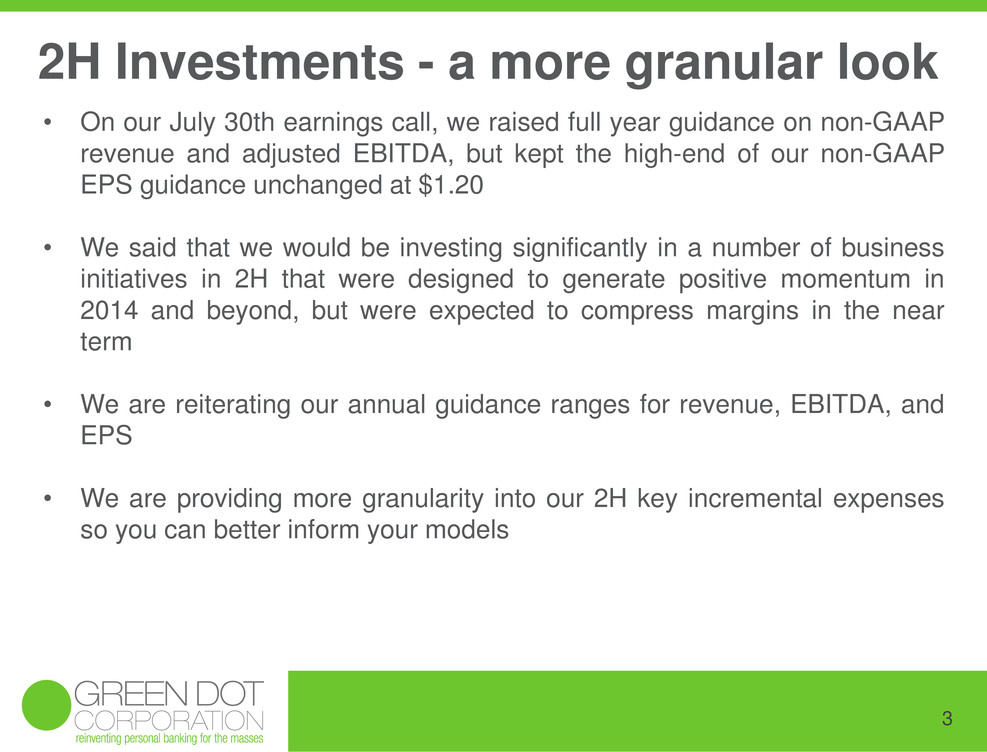
2H Investments - a more granular look • On our July 30th earnings call, we raised full year guidance on non-GAAP revenue and adjusted EBITDA, but kept the high-end of our non-GAAP EPS guidance unchanged at $1.20 • We said that we would be investing significantly in a number of business initiatives in 2H that were designed to generate positive momentum in 2014 and beyond, but were expected to compress margins in the near term • We are reiterating our annual guidance ranges for revenue, EBITDA, and EPS • We are providing more granularity into our 2H key incremental expenses so you can better inform your models 3
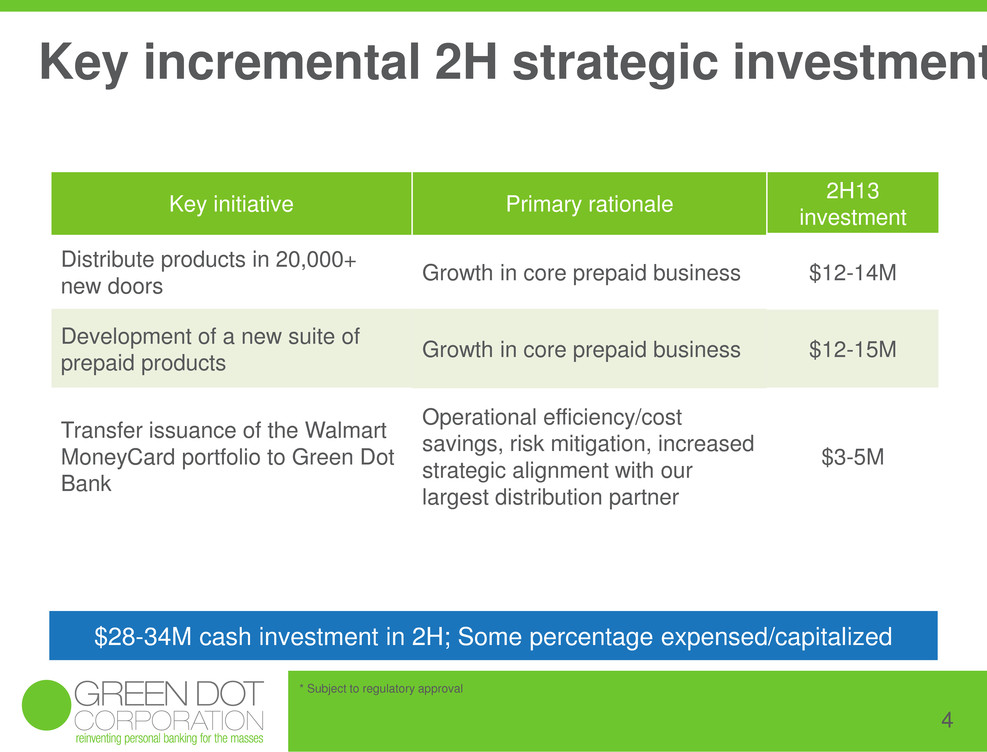
* Subject to regulatory approval Key initiative Primary rationale 2H13 investment Distribute products in 20,000+ new doors Growth in core prepaid business $12-14M Development of a new suite of prepaid products Growth in core prepaid business $12-15M Transfer issuance of the Walmart MoneyCard portfolio to Green Dot Bank Operational efficiency/cost savings, risk mitigation, increased strategic alignment with our largest distribution partner $3-5M $28-34M cash investment in 2H; Some percentage expensed/capitalized 4 Key incremental 2H strategic investments

Raised guidance on July 30th based on strength of core business We reiterate our outlook for 2013 Current Full year 2013 Low High Non-GAAP Total Operating Revenues $565M $575M Adjusted EBITDA $95M $105M Non-GAAP Diluted EPS $1.05 $1.20 Reconciliations of total operating revenues to non-GAAP total operating revenues, net income to non-GAAP net income, diluted earnings per share to non-GAAP diluted earnings per share and net income to adjusted EBITDA, respectively, are provided in the tables in the Appendix section. Additional information about the Company's non-GAAP financial measures can be found under the caption “About Non-GAAP Financial Measures.” 5
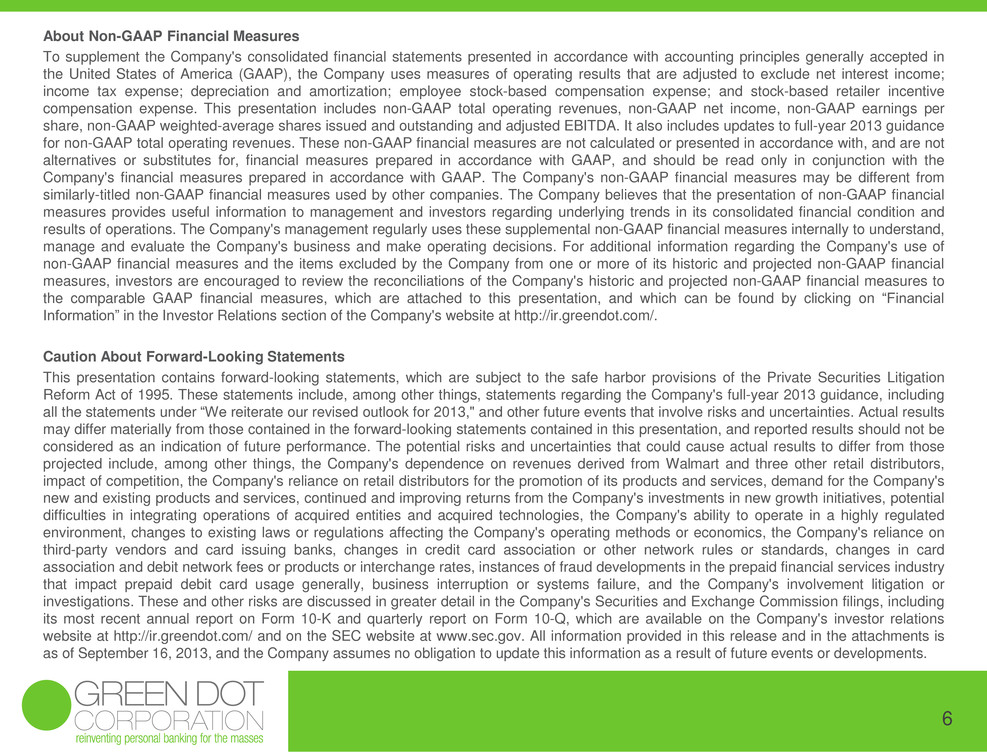
6 About Non-GAAP Financial Measures To supplement the Company's consolidated financial statements presented in accordance with accounting principles generally accepted in the United States of America (GAAP), the Company uses measures of operating results that are adjusted to exclude net interest income; income tax expense; depreciation and amortization; employee stock-based compensation expense; and stock-based retailer incentive compensation expense. This presentation includes non-GAAP total operating revenues, non-GAAP net income, non-GAAP earnings per share, non-GAAP weighted-average shares issued and outstanding and adjusted EBITDA. It also includes updates to full-year 2013 guidance for non-GAAP total operating revenues. These non-GAAP financial measures are not calculated or presented in accordance with, and are not alternatives or substitutes for, financial measures prepared in accordance with GAAP, and should be read only in conjunction with the Company's financial measures prepared in accordance with GAAP. The Company's non-GAAP financial measures may be different from similarly-titled non-GAAP financial measures used by other companies. The Company believes that the presentation of non-GAAP financial measures provides useful information to management and investors regarding underlying trends in its consolidated financial condition and results of operations. The Company's management regularly uses these supplemental non-GAAP financial measures internally to understand, manage and evaluate the Company's business and make operating decisions. For additional information regarding the Company's use of non-GAAP financial measures and the items excluded by the Company from one or more of its historic and projected non-GAAP financial measures, investors are encouraged to review the reconciliations of the Company's historic and projected non-GAAP financial measures to the comparable GAAP financial measures, which are attached to this presentation, and which can be found by clicking on “Financial Information” in the Investor Relations section of the Company's website at http://ir.greendot.com/. Caution About Forward-Looking Statements This presentation contains forward-looking statements, which are subject to the safe harbor provisions of the Private Securities Litigation Reform Act of 1995. These statements include, among other things, statements regarding the Company's full-year 2013 guidance, including all the statements under “We reiterate our revised outlook for 2013," and other future events that involve risks and uncertainties. Actual results may differ materially from those contained in the forward-looking statements contained in this presentation, and reported results should not be considered as an indication of future performance. The potential risks and uncertainties that could cause actual results to differ from those projected include, among other things, the Company's dependence on revenues derived from Walmart and three other retail distributors, impact of competition, the Company's reliance on retail distributors for the promotion of its products and services, demand for the Company's new and existing products and services, continued and improving returns from the Company's investments in new growth initiatives, potential difficulties in integrating operations of acquired entities and acquired technologies, the Company's ability to operate in a highly regulated environment, changes to existing laws or regulations affecting the Company's operating methods or economics, the Company's reliance on third-party vendors and card issuing banks, changes in credit card association or other network rules or standards, changes in card association and debit network fees or products or interchange rates, instances of fraud developments in the prepaid financial services industry that impact prepaid debit card usage generally, business interruption or systems failure, and the Company's involvement litigation or investigations. These and other risks are discussed in greater detail in the Company's Securities and Exchange Commission filings, including its most recent annual report on Form 10-K and quarterly report on Form 10-Q, which are available on the Company's investor relations website at http://ir.greendot.com/ and on the SEC website at www.sec.gov. All information provided in this release and in the attachments is as of September 16, 2013, and the Company assumes no obligation to update this information as a result of future events or developments.

Outlook 2013 * Assumes the Company's right to repurchase lapses on 36,810 shares per month during 2013 of the Company's Class A common stock at $19.79 per share, our market price on the last trading day of the second quarter 2013. A $1.00 change in the Company's Class A common stock price represents an annual change of $441,720 in stock- based retailer incentive compensation. Unaudited Low High Total operating revenues 557$ 567$ Stock-based retailer incentive compensation (2)* 8 8 Non-GAAP total operating revenues 565$ 575$ Reconciliation of Forward Looking Guidance for Non-GAAP Financial Measures to Projected GAAP Total Operating Revenue (1) Range ($ in millions) Reconciliation of net income to adjusted EBITDA (1) Low High Net income 32$ 39$ Adjustments (5) 63 66 Adjusted EBITDA 95$ 105$ Non-GAAP total operating revenues 575$ 565$ Adjusted EBITDA/Non-GAAP total operating revenues 17% 19% Range ($ in millions) 7
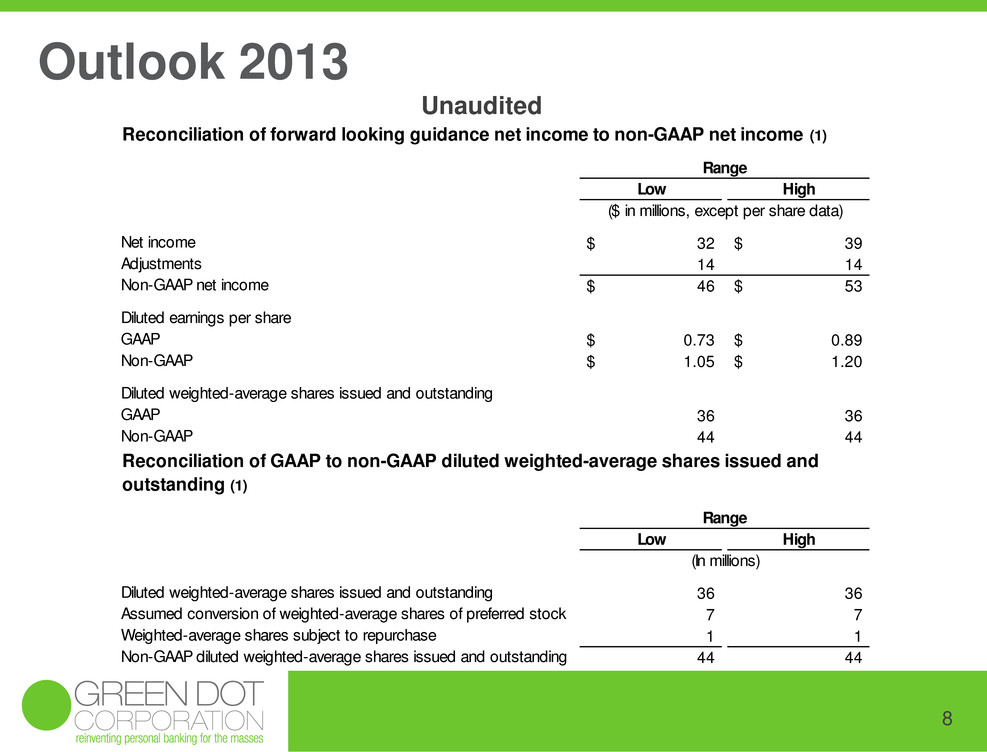
Outlook 2013 Reconciliation of forward looking guidance net income to non-GAAP net income (1) Low High Net income 32$ 39$ Adjustments 14 14 Non-GAAP net income 46$ 53$ Diluted earnings per share GAAP 0.73$ 0.89$ Non-GAAP 1.05$ 1.20$ Diluted weighted-average shares issued and outstanding GAAP 36 36 Non-GAAP 44 44 Range ($ in millions, except per share data) Unaudited Low High Diluted weighted-average shares issued and outstanding 36 36 Assumed conversion of weighted-average shares of preferred stock 7 7 Weighted-average shares subject to repurchase 1 1 Non-GAAP diluted weighted-average shares issued and outstanding 44 44 Range (In millions) Reconciliation of GAAP to non-GAAP diluted weighted-average shares issued and o standing (1) 8
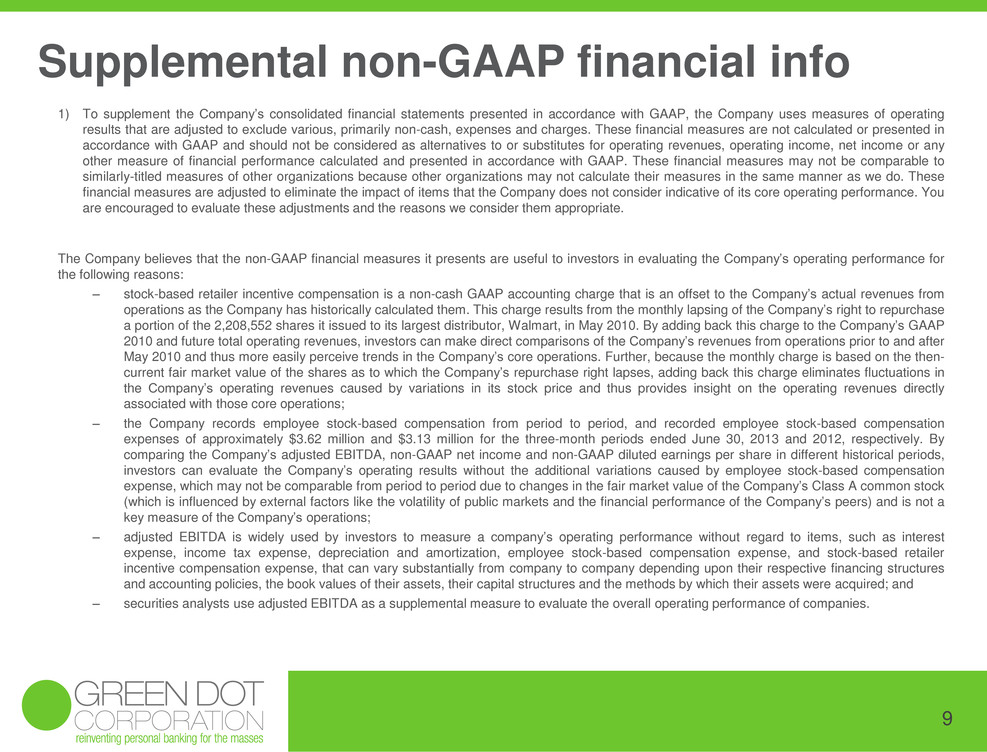
Supplemental non-GAAP financial info 1) To supplement the Company’s consolidated financial statements presented in accordance with GAAP, the Company uses measures of operating results that are adjusted to exclude various, primarily non-cash, expenses and charges. These financial measures are not calculated or presented in accordance with GAAP and should not be considered as alternatives to or substitutes for operating revenues, operating income, net income or any other measure of financial performance calculated and presented in accordance with GAAP. These financial measures may not be comparable to similarly-titled measures of other organizations because other organizations may not calculate their measures in the same manner as we do. These financial measures are adjusted to eliminate the impact of items that the Company does not consider indicative of its core operating performance. You are encouraged to evaluate these adjustments and the reasons we consider them appropriate. The Company believes that the non-GAAP financial measures it presents are useful to investors in evaluating the Company’s operating performance for the following reasons: – stock-based retailer incentive compensation is a non-cash GAAP accounting charge that is an offset to the Company’s actual revenues from operations as the Company has historically calculated them. This charge results from the monthly lapsing of the Company’s right to repurchase a portion of the 2,208,552 shares it issued to its largest distributor, Walmart, in May 2010. By adding back this charge to the Company’s GAAP 2010 and future total operating revenues, investors can make direct comparisons of the Company’s revenues from operations prior to and after May 2010 and thus more easily perceive trends in the Company’s core operations. Further, because the monthly charge is based on the then- current fair market value of the shares as to which the Company’s repurchase right lapses, adding back this charge eliminates fluctuations in the Company’s operating revenues caused by variations in its stock price and thus provides insight on the operating revenues directly associated with those core operations; – the Company records employee stock-based compensation from period to period, and recorded employee stock-based compensation expenses of approximately $3.62 million and $3.13 million for the three-month periods ended June 30, 2013 and 2012, respectively. By comparing the Company’s adjusted EBITDA, non-GAAP net income and non-GAAP diluted earnings per share in different historical periods, investors can evaluate the Company’s operating results without the additional variations caused by employee stock-based compensation expense, which may not be comparable from period to period due to changes in the fair market value of the Company’s Class A common stock (which is influenced by external factors like the volatility of public markets and the financial performance of the Company’s peers) and is not a key measure of the Company’s operations; – adjusted EBITDA is widely used by investors to measure a company’s operating performance without regard to items, such as interest expense, income tax expense, depreciation and amortization, employee stock-based compensation expense, and stock-based retailer incentive compensation expense, that can vary substantially from company to company depending upon their respective financing structures and accounting policies, the book values of their assets, their capital structures and the methods by which their assets were acquired; and – securities analysts use adjusted EBITDA as a supplemental measure to evaluate the overall operating performance of companies. 9
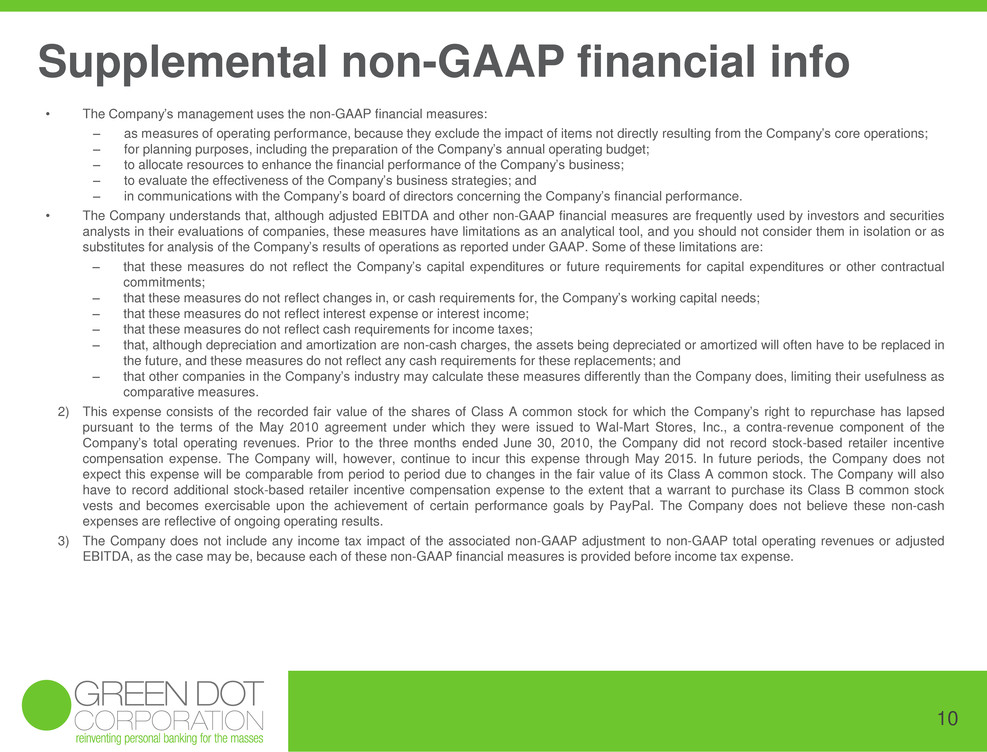
Supplemental non-GAAP financial info • The Company’s management uses the non-GAAP financial measures: – as measures of operating performance, because they exclude the impact of items not directly resulting from the Company’s core operations; – for planning purposes, including the preparation of the Company’s annual operating budget; – to allocate resources to enhance the financial performance of the Company’s business; – to evaluate the effectiveness of the Company’s business strategies; and – in communications with the Company’s board of directors concerning the Company’s financial performance. • The Company understands that, although adjusted EBITDA and other non-GAAP financial measures are frequently used by investors and securities analysts in their evaluations of companies, these measures have limitations as an analytical tool, and you should not consider them in isolation or as substitutes for analysis of the Company’s results of operations as reported under GAAP. Some of these limitations are: – that these measures do not reflect the Company’s capital expenditures or future requirements for capital expenditures or other contractual commitments; – that these measures do not reflect changes in, or cash requirements for, the Company’s working capital needs; – that these measures do not reflect interest expense or interest income; – that these measures do not reflect cash requirements for income taxes; – that, although depreciation and amortization are non-cash charges, the assets being depreciated or amortized will often have to be replaced in the future, and these measures do not reflect any cash requirements for these replacements; and – that other companies in the Company’s industry may calculate these measures differently than the Company does, limiting their usefulness as comparative measures. 2) This expense consists of the recorded fair value of the shares of Class A common stock for which the Company’s right to repurchase has lapsed pursuant to the terms of the May 2010 agreement under which they were issued to Wal-Mart Stores, Inc., a contra-revenue component of the Company’s total operating revenues. Prior to the three months ended June 30, 2010, the Company did not record stock-based retailer incentive compensation expense. The Company will, however, continue to incur this expense through May 2015. In future periods, the Company does not expect this expense will be comparable from period to period due to changes in the fair value of its Class A common stock. The Company will also have to record additional stock-based retailer incentive compensation expense to the extent that a warrant to purchase its Class B common stock vests and becomes exercisable upon the achievement of certain performance goals by PayPal. The Company does not believe these non-cash expenses are reflective of ongoing operating results. 3) The Company does not include any income tax impact of the associated non-GAAP adjustment to non-GAAP total operating revenues or adjusted EBITDA, as the case may be, because each of these non-GAAP financial measures is provided before income tax expense. 10

Supplemental non-GAAP financial info 4) This expense consists primarily of expenses for employee stock options. Employee stock-based compensation expense is not comparable from period to period due to changes in the fair market value of the Company’s Class A common stock (which is influenced by external factors like the volatility of public markets and the financial performance of the Company’s peers) and is not a key measure of the Company’s operations. The Company excludes employee stock-based compensation expense from its non-GAAP financial measures primarily because it consists of non-cash expenses that the Company does not believe are reflective of ongoing operating results. Further, the Company believes that it is useful to investors to understand the impact of employee stock-based compensation to its results of operations. 5) These amounts represent estimated adjustments for net interest income, income taxes, depreciation and amortization, employee stock-based compensation expense, and stock-based retailer incentive compensation expense. Employee stock-based compensation expense and stock-based retailer incentive compensation expense include assumptions about the future fair market value of the Company’s Class A common stock (which is influenced by external factors like the volatility of public markets and the financial performance of the Company’s peers). 11
